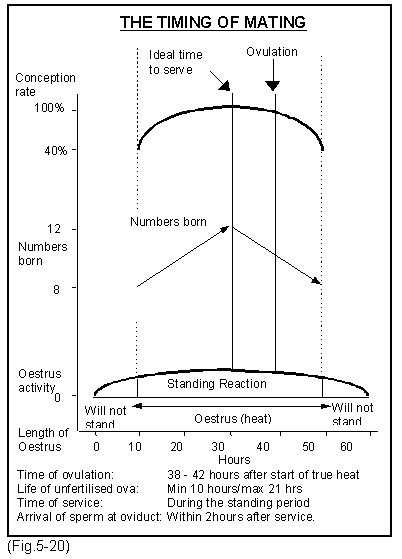



Losses due to fertilisation
These are associated with failure or poor quality of fertilisation or conception. If total failure occurs then the sow will repeat on a normal cycle of 18-22 days. If however conception is poor, due for example to overworked boars, then either litter size or its variation will be affected, or a decrease in farrowing rate will be seen with increased regular returns, together with an increase in irregular returns.
Within an hour after service, contractions of the muscles in the womb move the sperm rapidly up to the openings of the oviducts (fallopian tubes). Once this area (the utero-tubal junction) is filled with sperm few more can enter until ovulation occurs. This suggests that the first mating may well be the important one in the ultimate reproductive performance. It then becomes an arguable point in terms of litter size whether any subsequent matings are of great value. (See single mating).
Do not feed high levels for 48 hours post-service (>2kg) or you can expect some poor litters
Sperm have to remain at the utero-tubal junction for about 6 hours and develop (capacitation) before they are fully able to fertilise the ova. Since the unfertilised ova can only remain viable in the oviducts for 8-10 hours it is important that mating is carried out at the correct time i.e. <10 hours before ovulation (egg release). Ovulation takes place two-thirds through the heat period usually about 40 hours after the true standing heat started.
Key factors in maximising fertilisation
- A complete failure will obviously occur if the animal is not served. This is not as silly as it sounds. A service house person may well think a sow has been served when in fact it has not.
- To ensure maximum meeting of sperm and egg, only carry out the first mating when the sow is standing "rock hard" or completely immobile.
- Do not serve sows in the early part of the oestrus period.
- Only use a boar once every 24 hours.
- Ensure that the boar's penis is entered into the vagina and locked into the cervix. Ensure that there is no leak back of semen.
- View the boar from behind and look above his testicles to ensure that he ejaculates, by evidence of the urethra pulsating.
- Failure to place semen into the womb results in poor fertilisation.
- To ensure maximum fertility and litter size serve in the fertile period, that is, from weaning up to day 7.
- Ensure that sows are fed no more than 2kg of feed for the first 2 days post-service. High levels of feed may reduce progesterone levels and this may result in higher embryo mortality. When the sow is in oestrus, she is under the influence of high levels of oestrogens. Towards the end of the heat period these drop and progesterone levels start to rise. Sows with high levels of progesterone provide a good nutritious environment for the fertilised embryo and potentially good litters. Some sows with low progesterone levels will have increased levels of embryo mortality
- The fertilised eggs remain in the oviducts for approximately 48 hours before they migrate down to the horns of the womb. It is safe to change the sow's environment during his time.
- Any management change, mixing, or movement should therefore take place in this immediate post-service period only.
A return at 18-23 days indicates either group 2 or group 3 losses or failure of implantation in group 4. If there is progressive loss in group 3, then litter size will be low, there will be an increase in litter size variation and a decrease in farrowing rates. Fig.5-20 demonstrates the effects of the timing of insemination and ovulation and subsequent results. If insemination takes place in the early part of the oestrus period, even when the sow will stand to the boar, both conception rate and numbers born are compromised. Study Fig.5-14 again because it will help you to understand how records can pinpoint the specific time of the failure. With this information the management practices and contributing factors are identified on the farm and this allows corrective action to be taken.
Fig.5-20 provides a good guide to the optimum time of mating but be aware that there is considerable variation between individual sows particularly in the time of ovulation and the time that they come on heat. Most sows come on heat in the early hours of the morning, around 4.00 am which means that the optimum time to mate them would be 30 hours later, 10 o'clock on the following day.
Repeat matings on a normal 18 - 22 day cycle
Possible causes and corrective factors for group 3 and some group 4 losses
Twenty one day repeats indicate that pregnancy failure is occurring from service to approximately 10 days post-service. An assessment of management and mating procedures are therefore necessary, particularly to identify any form of stress on the sow.
The target level of efficiency in this category would be 5-8% of repeat matings. Fig.5-21 can be used to highlight areas of importance. The role and presence of the boar is particularly important in group 3 and 4 losses. There are three golden rules relating to his use.
- Only use each boar once every 24 hours.
- Only serve a sow when she is standing absolutely "rock hard" or still.
- Ensure there is a good insemination, and quality of mating. (1 = good, 2 = moderate, 3 = poor).








